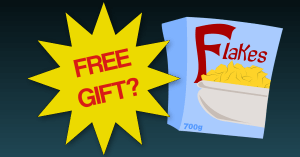Recent events have brought into focus how we position ourselves when attracting leads into our online businesses.
In this post, I want to reach into the past and have a look as some models that have now become prevalent in listbuilding and ask – Is this really the best way?
Having grown up in the 60s and 70s I was the target for some wonderful marketing techniques. All sorts of stuff quickly became “must haves” purely down to the skills of top marketing and advertising executives reaching directly into the heads of impressionable young people. Like me.
I remember things like Johnny 7 toy guns, Raleigh Chopper bicycles and various types of shoes – George Best slip on shoes (made of plastic with a red sole engraved with his autograph) and “Wayfarers” – shoes which had animal tracks on the sole and a hidden compass in the heel were the big hitters.
 Perhaps the most persuasive & aggressive kind of marketing (and for the least material benefit) was the various campaigns run by the big breakfast cereal manufacturers. This was war on a big scale.
Perhaps the most persuasive & aggressive kind of marketing (and for the least material benefit) was the various campaigns run by the big breakfast cereal manufacturers. This was war on a big scale.
Like many “wars” it all started on a fairly small scale. On the back of a box of breakfast cereal, they may have printed a rudimentary board game where you had to cut out the counters from the side of the pack and make a dice by cutting out a hexagon and putting a matchstick in the middle. Simple stuff.
But it escalated very quickly in the way that only true wars do.
Soon, there were gifts inside the packets. They were often tied in to popular TV shows or well loved cartoon characters. They were short campaigns designed to make kids pester their moms to buy a certain cereal so they could collect the full set of rubbish plastic items that had been elevated by amazing copywriters, graphic artists and advertisers into something of quite extraordinarily value.
Here’s the interesting thing about these campaigns….
The very best gifts were always found in the boxes of cereals that kids normally hated.
I remember feeling very hard done by when new campaigns for Shreddies went live as my mother refused to buy them. Only because no-one in the family could stand eating them.
It was almost like the manufacturers knew that their product was a bit rubbish and pushed the gift to front and centre to obscure and distract from this.
You know what – nothing has changed. The most attractive “free gifts” are almost always offered by the purveyors of the shittest products. McDonalds is, perhaps, a prime example.
The marketers had done a good job. People wanted the gift. Only the gift.
It was a chore to have to lug home a whole box of cereal that they got as a by-product of getting the gift. It was sad and annoying that the open box(es) of cereal, still mostly full, sat at the back of the pantry 6 months later, long after the plastic toy had been lost or discarded.
It is also a bit sad that email marketing has gone the same way.
Let me ask you a question….
When you attract leads onto your list, what are you hoping to achieve?
Here’s what your answer should be; you want to offer great value to the new subscriber through your emails and, in doing so, establish yourself as an authority in your niche over time so they will know (hopefully like) and trust you.
Then they will buy from you, right? When was the last time you bought anything off someone you didn’t know, disliked and didn’t trust?
It should be the email content that offers the value, not just the free gift. Over the last few years, however, it is the freebie – the “lead magnet”, the “ethical bribe” – that has been placed front and centre.
But is that about to change?
One aspect of the new GDPR regulations is the requirement to offer people granular consent. In other words, if your squeeze page just “sells” the free pdf, that is what you deliver. Nothing else. No ongoing unrelated sales or marketing emails. Unless the subscriber ticks a box to agree to something extra, you can only deliver what is promised.
You can’t focus on your spiffy plastic Spiderman figure and, when people get it, immediately start shovelling breakfast cereal through their letterbox. They didn’t ask for the bloody cereal. They don’t want the bloody cereal.
It becomes a harder proposition, then to convince them that the cereal is good for them and they should open it and consume it whenever you send them some.
Now, I know that there will be a whole load of marketers who will simply ignore all of these pesky rules. It will be business as usual for them as the downside of having to think about their business model and making changes will be greater than the risk of any issue coming from the authorities.
But I think that approach stifles creative thought (an leaves you open for potential legal issues – however remote that may be).
You see, I believe that selling the cereal and still offering a cool gift is the better way.
Yes, people will still probably sign up to get the free gift, just like they did before (especially if it is a sexy one), but by selling the value you are giving in your newsletter, you are re-emphasising that you are an authority, that you will help them and it would greatly enhance their results by opening your mails.
It is all a question of positioning.
Rather than just having a freebie as your reason for people to subscribe, lead with your emails and offer the freebie as a free gift – an added extra.
So instead, big up your newsletter. Like this…
“I Can Help You. I Will Help You. Sign up now to start receiving FREE [NICHE] tips, tutorials and insights and discover ways to [BENEFIT] every day!”
“And, as a thank you for subscribing, you will receive this FREE gift in your first email – [THEN BIG UP THE GIFT]”
Tips, tutorials and insights cover just about anything. You can write product reviews, link to a blog post, tell people about tools or trainings that they may benefit from (and pop affiliate links in where appropriate). The important thing is – that is what they are signing up for.
The fact remains that many will subscribe just to get the sexy freebie. That’s fine, they can unsubscribe at any time (you can even tell them that on the squeeze page). But there are two things at work here that will benefit you….
Firstly, you have been explicit in your offer – they can’t say that they didn’t know that they were signing up to receive regular emails about your niche and they have given consent for that.
Secondly, they are expecting you to send them emails. You may find that your open rate will be higher as you have planted the seed of expectation. If you do, indeed, deliver good content as you have promised to do, you will find that you will maintain that high open rate over time.
My “tutorial style” email sequences that deliver real value (and in doing so make people aware of trainings and tools that are relevant) have a much higher long term open rate and click rate than broadcasts.
Please comment with your thoughts. If you think that others may benefit from this post, please share on social media by using the share buttons just below.
If you want to stay up to date with this blog, why not subscribe. There are three easy ways to do that…
You can get push notifications by clicking on the red bell over to the left, you can get notified in Facebook Messenger by clicking here and you can get email notifications by clicking here (Or you can do all three if you wish)
Like this? Share it with others...





1 comments
Classic example of doing the opposite of what the so called marketing gurus tell you because most of them downplay the email sequences and strongly encourage major focus on impromptu BROADCAST emails instead. They claim the sequences are not as effective due to too many people using the same sequences thus making autoresponder companies not deliver them to user’s primary inboxes yet broadcasts somehow do make it..
BUT the sequences are what keeps subscribers on track and in succinct flow with the ultimate message you intend to covey while the broadcasts accent that ultimate message and introduce real time info right in the moment!
I remember the different cereals with their different prizes and toys inside too and although these types of campaigns may have brought initial sales boosts to those companies, the ones that tasted bad suffered in the long run.
Lesson learned is that gimmicks cannot replace or make up for TRUE VALUE.